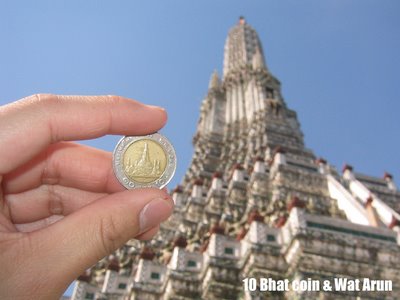During my week-long stay in Bangkok, we managed to squeeze in two brief tours of the city. It really would've been better if I'd taken off to explore on my own for days. Being that I was there for a conference (honest!), it really wasn't too bad. At least we got to see some of the Thai cultural icons ~ Wats.
What's a Wat?
In a nutshell, it's a Buddhist temple from the Cambodian, Lao or Thailand region. Click '
HERE' for a more detailed definition.
Wat Arun (Temple of Dawn) was one of the gems we visited on the first of our Chao Phraya River tour. Located on the Western banks/Thonburi area of the city, it consists of a center tower (Khmer style prang), boasting 104m tall, with 4 smaller prangs seeded at its corners. All of the towers are adorned by pieces of Chinese porcelain.

Nothing sits within this temple. This is only a structure, with no rooms or halls for believers to pray in. Although it once housed the infamous Emerald Buddha, the relic has now been moved to Wat Phra Kaew, closer to the Grand Palace.

Noting that Wat Arun is probably one of the most published images of Bangkok, it is also on the back of a 10Baht (USD$0.25) coin.
 Wat Pho, or Phra Chetuphon as known by the locals, impressed me the most.
Wat Pho, or Phra Chetuphon as known by the locals, impressed me the most.
 Wat Pho dates back to about 200 years prior to Bangkok being established as the capital of Siam in 1782 by King Rama I. It is by the Grand Palace, housing a 13m (43ft) high and 46 meter (151ft) long sleeping Buddha.
Wat Pho dates back to about 200 years prior to Bangkok being established as the capital of Siam in 1782 by King Rama I. It is by the Grand Palace, housing a 13m (43ft) high and 46 meter (151ft) long sleeping Buddha.
At the temple, handfuls of beads could be offered up as prayers, placing them one by one into the bowls while walking alongside the temple walls.
Wat Traimit in the China Town area was one of the interesting ones. In there, sat a statue of Buddha, made out of 5,500kg (12,000lbs)!
At first glance, the 3m high Buddha image in here looks distinctly average and undeserving of the busloads of tourists that visit every day. What attracts them all however, is the remarkable fact that it's made of 5.5 tonnes of solid gold.
 The story behind the image is that in 1957 a large stucco Buddha image was being moved by crane during development of a port. To the horror of all concerned, the crane operator accidentally dropped the image, sending it crashing towards the ground. Instead of smashing however, the stucco covering merely cracked and in the process revealed the solid gold image hidden underneath. It is thought to have been covered like this during the early Ayuthaya or Sukhothai period, apparently to protect the image from the invading Burmese, and remained that way for several hundred years.
The story behind the image is that in 1957 a large stucco Buddha image was being moved by crane during development of a port. To the horror of all concerned, the crane operator accidentally dropped the image, sending it crashing towards the ground. Instead of smashing however, the stucco covering merely cracked and in the process revealed the solid gold image hidden underneath. It is thought to have been covered like this during the early Ayuthaya or Sukhothai period, apparently to protect the image from the invading Burmese, and remained that way for several hundred years.
- into-asia.com
Wats are everywhere in Bangkok. Turn every corner, and you'll see a Wat here, there, and everywhere!


Kings continually to built temples in the capital. Probably the last official one being built by the kings, as we were told, was
Wat Benchamabophit ~ or Marble Temple. Construction commenced in 1899, under orders of King Chulalongkorn. This is a UNESCO world heritage site, housing 52 Buddha statues, an intricate roof (inside and outside), and is actually still being used by monks for meditation.
I'd like to go on and on about more of the places we visited, and the histories, but I guess that's probably enough about Wats for now.
If you'd like to see more pictures of the trip, not only of temples, do click on my photo album link on the blog's sidebar, or
'HERE'.
 I'm always an advocate of 'Doing the right thing'. This includes applying for work permits when you go to a foreign country for employment.
I'm always an advocate of 'Doing the right thing'. This includes applying for work permits when you go to a foreign country for employment.





























